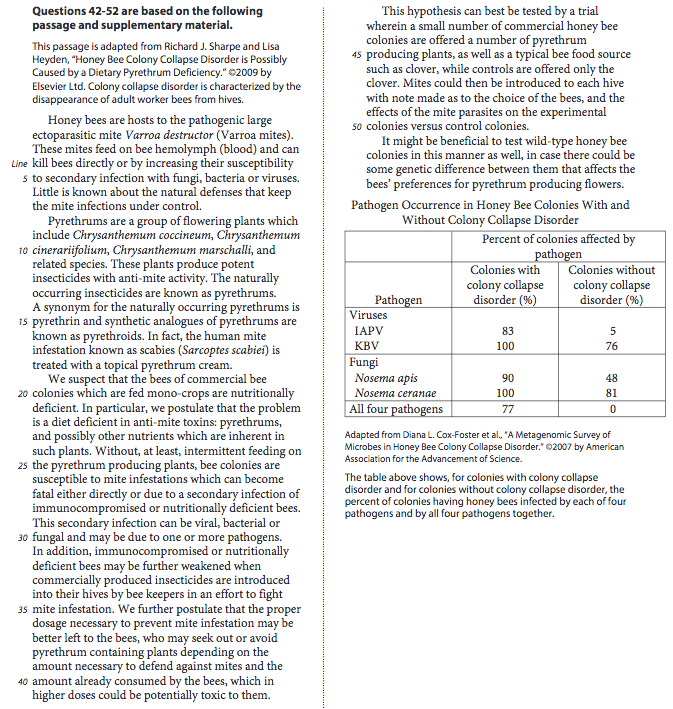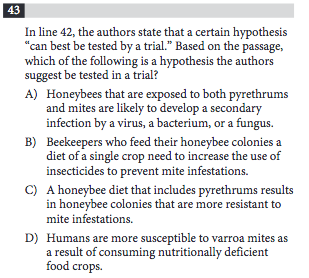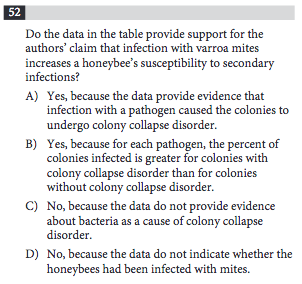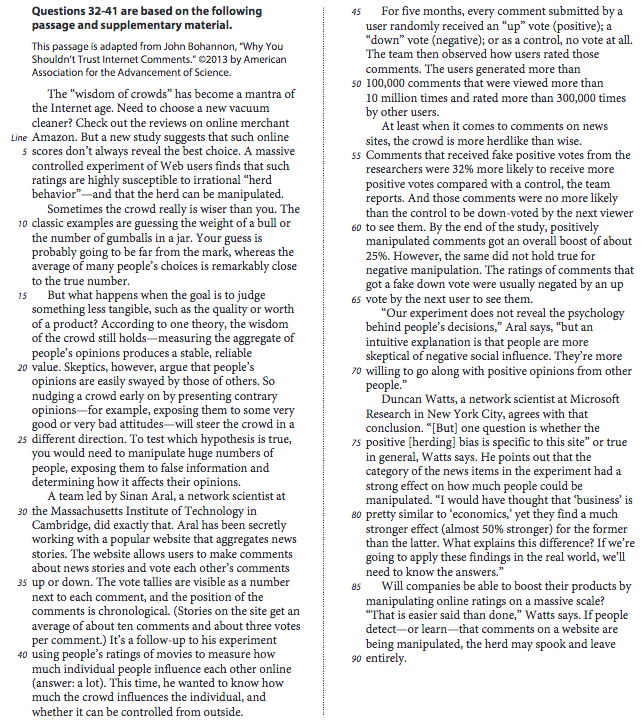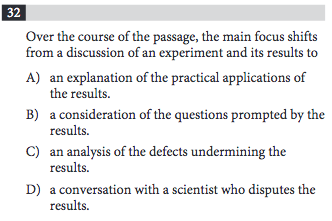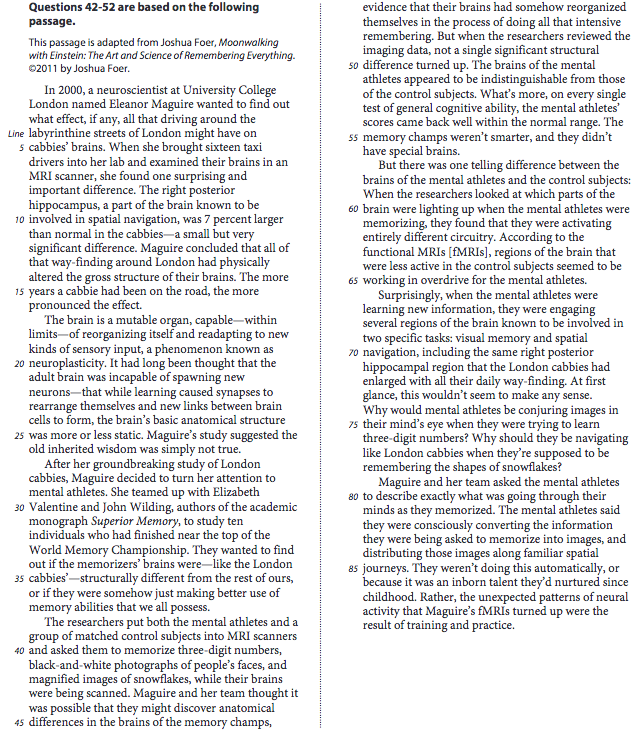How to Tackle the SAT Science Reading Passages
What’s Covered:
- What Does the SAT Reading Test Cover?
- How Will the SAT Impact My College Chances?
- Tips and Strategies for the SAT Science Passages
- Final Tips and Resources
The SAT Reading test has multiple components, one of which is the science section. The two science passages on the SAT can seem overwhelming since they are heavy with information and data. However, with practice, you can learn to synthesize and analyze the information in a way that will make reading the passages and answering the questions much easier.
Ultimately, the science-based questions test your ability to interpret data. In this post, we will go over the format of the science passages and share strategies to best answer the corresponding questions.
What Does the SAT Reading Test Cover?
The SAT Reading section does not measure how well you memorize facts and definitions, instead it measures your ability to interpret texts and informational graphics. The reading score is combined with the SAT Writing and Language score and scaled to constitute a score out of 800. So, doing well on the reading section is imperative to obtaining a great SAT score overall.
This reading section consists of 52 questions to be answered in 65 minutes. Each question is multiple choice and corresponds to a passage and any corresponding informational graphics.
The test contains passages in a variety of topics including:
- One classic or contemporary work of U.S. or world literature.
- One or two historical passages from either a U.S. founding document or a text in the Great Global Conversation they inspired, such as the U.S. Constitution or a speech by a historical figure.
- One social science passage covering economics, psychology, or sociology.
- Two science passages (or one passage and a passage pair) that examine foundational concepts and developments in Earth science, biology, chemistry, or physics.
This post will focus on the science passages. Answering this type of question requires students to examine hypotheses, interpret data, and consider implications. These passages often include charts, graphs, or tables to supplement the text. Though the text covers scientific concepts, you won’t need any specific scientific knowledge to answer these questions – having strong reading comprehension and analytical skills is sufficient.
How Will the SAT Impact My College Chances?
Before we dive into the science section, we want to stress how important the SAT is for college admissions. Many selective colleges look at a metric called the Academic Index (AI) to assess an applicant’s strength. This statistic takes into account data like SAT/ACT scores and GPA, and many competitive schools will automatically reject applications with AIs that are too low. So, you should make sure you prioritize studying for the SAT in your college admissions process!
To see how your SAT score stacks up against other applicants, check out CollegeVine’s free Admissions Chances Calculator. This tool will not only tell you your chances of admissions, but also how best to improve other aspects of your profile.
Tips and Strategies for the SAT Science Passages
Here are some tips to help you prepare for the SAT science passages. The sample questions below are taken directly from the CollegeBoard from their list of freely available resources. We encourage you to check out these resources to familiarize yourself with the types of questions you’ll encounter.
1. Summarize the information
The science passages often are about a certain animal, plant, natural phenomenon, or other scientific concept. As you read, a helpful mnemonic to keep in mind is WHW: what, how, and why. First, identify what (or who) is being studied – this is the subject of the passage. Next, take note of how the information is being presented; it may be an experiment, an analysis of the change of a population over time, an observational study, or merely presenting a hypothesis. Finally, determine why the subject is important. Think about why the author chose to inform you about this subject. Examples of this include studying a species because it is endangered or informing the readers about the dangers of hydraulic fracking.
Make sure that after reading, you are able to summarize the what, how, and why of the passage. This knowledge will help you answer the questions because many wrong answer choices are strategically put to see if readers did not correctly identify this information.
Here is a sample science passage about honey bees:
And a question testing your comprehension:
Answer: C
After reading the passage, the information could be summarized as follows:
What is the subject: Honey bees: specifically how certain plants they consume (called pyrethrums) grant them natural protection against mites.
How the information is presented: The authors propose a hypothesis and a method to test that hypothesis.
Why this is important: The authors suspect that bees in commercial bee colonies are more susceptible to mite infestations since they don’t have access to pyrethrums.
From this summary alone, you should be able to answer the question. Answer choices B and D are not relevant to the passage, and choice A contains false information. Choice C is correct in the context of the passage and the answer corresponds to the summary.
As you can see, taking a few seconds to jot down a summary of the passage will prove useful in understanding what the passage is about and answering the subsequent questions. Though you don’t have to write complete sentences like we did above (and you may not want to for the sake of time), write enough that you will be able to understand the important information when you look back at your notes.
2. Actively read
The SAT Reading science passages are very information-heavy. They contain lots of terms, facts, and figures, so actively reading can help your brain sort and understand the information. As you read, a good rule of thumb is to always keep your pencil in your hand. Reading shouldn’t just involve your eyes: use your pencil as much as possible to take notes, underline, or circle information.
Try to be strategic with your annotations – if you underline every other sentence, it defeats the purpose of establishing what information is important. Maybe reserve circles for important terms, underlining for conclusions or principles, and boxes for the most important information like hypotheses or the overall purpose of the passage.
The most important thing to keep in mind is that your annotations are for you! Do whatever makes the most sense and is most effective for you. As you complete practice tests, you can experiment with different annotation methods to find the one that works best.

[amp-cta id="9459"]
3. Pay attention to graphs, tables, and charts
Most science passages have corresponding graphs, tables, or charts. When you look at them, take note of what information is being presented by reading titles and labels. Also, try to understand the information within the context of the passage.
There are two main types of questions about informational graphics. The first type merely tests whether you can read the data. These questions are often fairly simple and don’t require looking at the passage.
Here is an example of this type of question using the chart shown above about honey bees:
Answer: B
Paying close attention to labels in the table should help you correctly answer these questions. In this case, we would look at the column labelled “Colonies with colony collapse disorder,” and the row titled “All four pathogens.” The corresponding cell contains the number 77, so the correct answer is B.
The second type of question asks about how the data relates to the passage. It’s important to be careful with these graphs and charts, because they do not always directly correspond to the passage. Pay attention to whether the information presented in the data supports, disputes, or is irrelevant to the information in the passage.
For instance, take a look at this sample question, which refers to the same passage and table as above:
Answer: D
In this case, the correct answer is D. This question is a good example of how the data in the table didn’t directly relate to the passage, because it provided information not relevant to the author’s hypothesis.
4. Look at the organization of the passage
For the science passages, you might be asked about the organization. Immediately after finishing reading the passage (while it’s still fresh in your mind) take a moment to write down the structure of the passage. This will be beneficial when answering any questions related to the organization of the passage.
Common formats include:
- Introducing a hypothesis, testing it, then examining the results
- Describing a problem, then exploring possible solutions
- Explaining a theoretical concept, then discussing conflicting viewpoints of it
Here’s an example passage:
And the question:
Answer: B
Answering this question requires that you understand the general structure of the passage. So, while reading the passage, try to write down a one-word summary of each paragraph in the margins. For instance, if a paragraph discusses the author’s hypothesis, write down “hypothesis.” Or, if the paragraph proposes possible solutions to a problem, write down “solutions” next to the paragraph.
This will offer a summary of the overall structure of the passage, and help you not only answer questions regarding organization, but also to better understand the passage as a whole.
For this particular question, the last two paragraphs contain additional questions from scientist Duncan Watts. A brief summary of these paragraphs could be “more questions.” Already having the passage summarized will allow you to easily determine that the answer to this question is B, since the passage shifts focus to a “consideration of the questions prompted by the results.”
5. Try not to use prior knowledge
Wrong answer choices may include information that is correct, but is not relevant to the passage. Just because a statement within an answer choice is true, doesn’t mean it’s the correct answer. Frustrating, right? So, it is important not to let your prior knowledge influence the way you answer these questions.
This is especially important in the science passages, since you may encounter a passage on a subject that you’ve learned about at some point in school (like tornados, biomes, specific animals, etc.).
This question exemplifies the dangers of outside knowledge:
And the question:
Answer: A
Based on the passage, the correct answer is A. This is evident from lines 57–62: “But there was one telling difference between the brains of the mental athletes and the control subjects: When the researchers looked at which parts of the brain were lighting up when the mental athletes are memorizing, they found that they were activating entirely different circuitry.”
Though the other three answer choices might be true, they are not the correct choice since they are not supported by the passage. Remember, the SAT operates on the assumption that students have no knowledge of the subjects discussed during the science passages. So, try not to be led astray by prior knowledge; instead, answer questions solely based off of the information given to you within the passage.
6. Skim the questions before reading the passage
Though this tactic is important throughout the entire SAT Reading test, it’s especially important within the science passages, which contain a lot of information. Looking at the questions beforehand will guide your reading and help you know what to focus on. You don’t need to read the questions fully; rather, just keep in mind what types of questions they are in general.
For example, if you notice that there is a question regarding organization, you’ll pay close attention to that while reading. Or, if you notice a question asks about the definition of a certain term, you can read more carefully when you see that term mentioned.
Skimming the questions before reading the passage might seem like a waste of time, but it will actually save you time. This is because when you read the passage, you’ll already be paying attention to the things you are being asked about. Then, when answering questions, you’ll likely come up with the correct answer more quickly, saving yourself time overall.
Final Tips and Resources
To do well on the SAT Science passages, it will help if you become comfortable and confident reading scientific passages. This could involve reading science writing on your own, then explaining or summarizing it for a friend to improve your scientific analysis skills.
If you find yourself struggling with these types of questions, be sure to complete many practice tests on this particular type of reading (websites like Khan Academy and College Board have great resources). The big message here is practice practice practice!!
Lastly, remember the test involves paying attention to detail while still taking note of the big picture. The test makers are trying to get you to pick incorrect responses so try to recognize where there might be a trap. Make sure you enter the test with confidence, after all, you’ve taken the time to learn about the structure of the test and the types of questions you’ll encounter. Be sure you are also well-fed and well-rested.
If you’d like to learn more about the SAT Reading section in general, check out our post, How to Tackle the SAT Literary Reading Passages.

